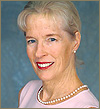
Kathleen Dracup
In her fourth state of the school address, UCSF School of Nursing Dean Kathy Dracup shared her concerns about chronic problems such as the nursing student and faculty shortage and consecutive permanent state budget cuts.
Dracup, who will begin her sixth year as dean in April, noted that when she first arrived at UCSF, California's coffers had a surplus of funds. Since then, however, the surplus has evaporated and the school has endured three consecutive years of budget cuts. State support is critical to the nursing school, which gets almost 40 percent of its revenues from the state, she says.
"Clearly, the challenge for me as a dean and you as faculty and staff is how do we grow in an environment where state support is shrinking?" Dracup asked. "Permanent cuts are very significant and they limit our imagination for growth."
Dracup says she is looking forward to some light at the end of the tunnel through the 2004 funding agreement negotiated between UC officials and Gov. Arnold Schwarzenegger. Greater state financial support, she says, will allow for modest increases in the budget, including funds to hike faculty and staff salaries, which have remained stagnant and have fallen below pay at comparable universities.
And while other schools can compensate for dwindling state support through clinical revenue or funds from patents, the School of Nursing does not have either of these options. The school's clinics, including Valencia Health Services, serve families who are mostly uninsured or Medi-Cal-assisted. The school's clinics often break even or cost the school money to care for the underserved, Dracup said.
Nevertheless, Dracup remained fairly upbeat in her 45-minute annual address on Feb. 25, saying that the school has made great strides in recent years to significantly boost other sources of revenue through alumni giving, corporate and foundation donations and through state, federal awards and other types of training and research grants. The UCSF School of Nursing remains the No. 1 nursing school in winning funds from the National Institutes of Health.
As she looks ahead, Dracup says her priorities are to:
• Implement the school's 2004 strategic plan, which outlines goals and objectives through the year 2009;
• Increase diversity among faculty and students, which is important in a state of rising ethnic populations;
• Develop new and innovative educational and clinical programs; and
• Enhance international programs and research, partly through expanded collaboration with the UCSF Global Health Program.
Addressing Nursing Shortfall
Calling the nursing shortage a "severe crisis," Dracup noted that the national vacancy rate of registered nurses is 14 percent. The situation is even more dire in the Golden State, as California ranks second to last among states in the ratio of nurses to general population.
Solving the nursing shortage is important especially when considering the aging population and that health sciences education will have to adapt to prepare future health professionals to care for seniors with multiple problems such as heart disease, arthritis and diabetes. "Health care of tomorrow is all about disease management," Dracup said.
The UCSF School of Nursing plays a critical role in helping to ease the nursing student shortage, in part by enrolling more students and preparing more nursing faculty to teach them. Student enrollment has increased by 100 since Dracup began leading the school. Still, even while being able to admit more students, including those in the Master's Entry into Professional Nursing, which increased from 60 to 76 this year, UCSF still has to turn away qualified nursing applicants.
UCSF is not alone, however; 56 percent of qualified nursing applicants were rejected in 2003 primarily because of a lack of faculty in nursing schools in the San Francisco Bay Area. Nationwide, Dracup reported that an astounding 125,000 qualified nursing applicants were turned down primarily because of too few faculty as well as a lack of clinical sites and state resources for public schools. (See video clip of Dracup discussing nursing faculty shortage in either
QuickTime or
Real format. Download
QuickTime or
Real media players.)
UC officials are working to address health sciences workforce needs for the 21st century, in part by examining workforce projections. Dracup served on a UC committee that studied the issue, and recommends boosting enrollment at both UCSF and UCLA schools of nursing by about 10 percent along with the financial resources to make it happen. That recommendation was approved by UC President Dynes and will be presented to the UC Regent review later this month.
Today, the US has a 12 percent shortage of faculty, which is expected to worsen with anticipated retirements over the next decade. The UCSF nursing school also expects to see a wave of retirements, Dracup noted, estimating that some 10 to 12 academic track faculty members could retire within the next five to eight years.
Faculty retirements do provide opportunities for new recruitments, Dracup said, adding that she has set a goal to double underrepresented minority faculty over the next five years. Nursing school leaders and faculty are expected to discuss that and other goals and priorities at the School of Nursing summit in April.
Closing her address on a positive note, Dracup quoted Bruce Spaulding, vice chancellor of University Advancement and Planning, who has played a pivotal role in the amazing growth and development at UCSF Mission Bay: "The secret to UCSF's success is that we make grand plans in recessionary times while others make timid plans."
Source: Lisa Cisneros
Related Links
UCSF School of Nursing

